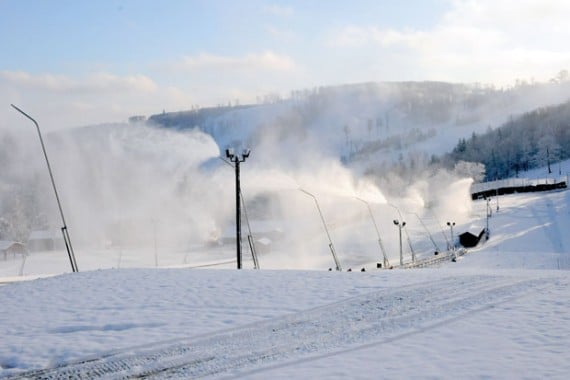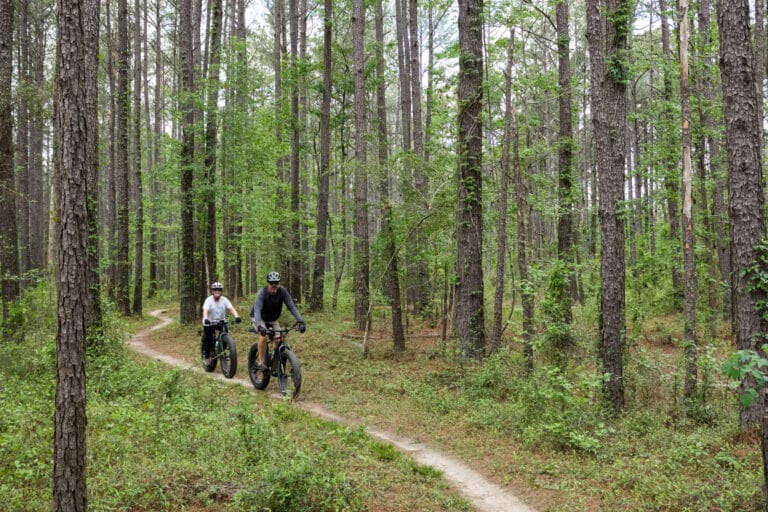Let It Blow: keeping the slopes covered takes as much science as nature these days.
Snowsports hope to bounce back from last year’s warm winter
Mother Nature can be a fickle broad. One minute, she blesses us with more snow than we can handle, the next she leaves us high and dry. The 2011-2012 ski season had much of North America struggling to keep the slopes covered and the lifts turning: bare slopes in California, endless sunshine in Utah, melting snowpack in Colorado. Only Montana and Wyoming were spared the brunt of Ms. Nature’s (as she will now respectfully be called) changing mood.
This is the challenge of being a snowsports junkie, especially in the mid-Atlantic or Southeast. Ski resorts in the Blue Ridge are dependent on nature’s bounty for sure, but cold temperatures are enough to manipulate the landscape into a wintery wonderland. We didn’t even get that last season. What gives?
“The last two seasons were a little bit of an anomaly, but they were as forecasted,” said Dave Dekema, marketing director at West Virginia’s Snowshoe Resort. “We worked to try and mitigate it heading into the season, but they were expected to be below average snowfall seasons with slightly warmer temperatures, and that’s exactly what we got.”
The statistics are staggering: visits to ski resorts were down 15 percent nationwide, the second lowest totals in 20 years and the highest percentage drop in 30 years. Nationally, 50 percent of resorts opened late and 48 percent closed early; average resort snowfall was at its lowest since the 1991-92 season. In the Southeast, the number of days resorts stayed open was down nearly 14 percent.
Now, the good news: ski resorts have a penchant for bouncing back. Ski resort visits rebounded 22 percent following the 1981-82 season when resort visits fell 17 percent from the previous year. Also, the 2010-11 season saw the largest number of skiers on the slopes ever, so the industry as a whole is trending upward. Forecasters are predicting colder temperatures in the Southeast, the strongest indicator for a solid ski season, says Dekema.
Farther north, at Seven Springs Mountain Resort in western Pennsylvania, communications manager Anna Weltz says the resort dealt with the dreaded ‘backyard effect’: “If people look out their back windows to their backyards and don’t see snow, they are not thinking about it,” Weltz explained. “So we’re using media outlets, local meteorologists, social media, and e-newsletters to say, ‘Hey, you may not have snow in your backyard, but we have plenty here.’”
Snowshoe is doubling down on its Snow Guarantee, a program that gives a free lift ticket to anyone who skis the resort on a day when it does not have the most terrain open in the region. Resorts are also pushing deeply discounted early bird ticket and lodging deals to entice skiers to commit to the season earlier and making general upgrades like lodge renovations or more signage to improve the overall mountain experience.
In addition, many Southern resorts are dedicating more resources to a four-season revenue stream to offset the ups and downs of the winter. Mountain bike parks and zip line tours are becoming more common at ski resorts.
On the slopes, more beginner terrain parks are aimed at attracting a broader audience, and upgrades to snowmaking infrastructure will improve the overall quality of the snow.
Ultimately, it’s not just the amount of snow that determines the success of a season. Timing of snowfall is often the difference between shredding pow and shredding dirt.
“We are making sure we are maximizing what we do get, when we get it,” Dekema said.
And it is not just the larger resorts that are stepping up their snowmaking game this season. Wintergreen Resort outside Nellysford, Va. is investing $12 million in resort upgrades this year, including $6 million specifically for snowmaking. The resort has built a new storage tank and pumping station it says will double its snowmaking capacity this season.
There is no doubt that Southern resorts have the ability to rebound from the dismal 2011-12 season, and with forecasters calling for a cold winter, Ms. Nature could be on board as well.
How Snowmaking Works
All ski resorts in the Blue Ridge rely on snowmaking for the bulk of their on-slope coverage. The first snowgun was invented in 1950, and their use became widespread by 1970 at resorts across the county. Here is a breakdown of the process:
•Water is piped through a special nozzle that shoots it into the air as very tiny particles. How small? The process is called “atomizing.” That’s how small.
•A second nozzle shoots out compressed air. When the compressed air is released, it becomes super cool – in temperature not social status – and freezes the atomized droplets.
•A second round of water is sprayed. These larger droplets latch on and freeze to the tinier droplets, forming flakes, and in turn huge piles of snow and/or an ice coating on your goggles.
•It takes about 200,000 gallons of water to cover an acre of slope with one foot of snow.








